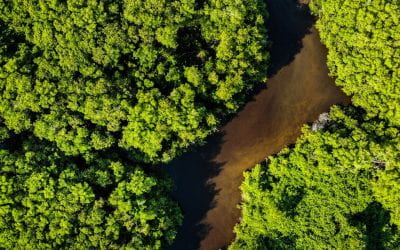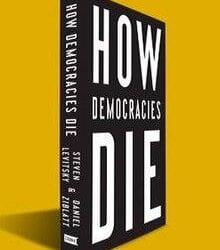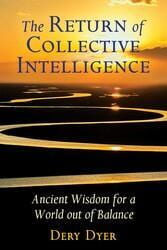A “Nonsensical Notebook”
Curiosidades de la montaña by Manuel María Albis
The 19th century continues to live within us in many ways. One of those ways is the presence of national typologies in our imagination. Cowboys, gauchos, harvesters and horsemen make up a portfolio of picturesque images that have found their way into movies, posters or publicity images for agro-exports such as the figure of Juan Valdés. To revisit these typologies is also to ask oneself why some of them have accumulated more symbolic power than others. The notebook of the priest Manuel María Albis is an incursion into a portfolio of discarded, uncomfortable typologies that did not serve the nation—or the shapers of 19th-century nationalism— for the creation of an image of a modern community. Why? The notebook that I propose to recuperate in these few pages restores to us communities that have no clear heirs, the communities of rochela, of shattered zones (to use Yale political scientist James C. Scott’s term), made up of deserters, indigenous communities and runaway slaves, who existed in the nooks and crannies or frontiers of a state that pressured its subjects into fleeing. My fascination with this text sprung from the same impulse to question how and why and with what agenda the collective self-portraits of a nation were constructed through the form of typologies.
Curiosidades de la montaña y médico en casa (Curiosidades) by Manuel María Albis (1823-¿?) is a fascinating book for those of us interested in the history and literature about the Amazon. However, its author, a Colombian priest and traveler, is still relatively unknown in Latin American historiography. Thanks to the small, but important, bibliography about him, in this short text, I wish to reintroduce the figure of Albis, as well as his only known work. Curiosidades is one of the few texts about Caquetá in the Colombian northwest Amazon region in the mid-19th century. His work is also extremely important in reflecting on plurilinguistic shatter zones without filtering them through the lens of national or European travelers. These “shatter zones” are plurilinguistic and pluricultural spaces characterized by “geographical inaccessibility and enormous diversity of tongues and cultures,” according to James C. Scott in The Art of Not Being Governed: An Anarchist History of Upland Southeast Asia (New Haven: Yale University Press, 2009).
Only one edition exists of Albis’ book. It is a valuable bilingual Italian-Spanish edition, prepared by Alberto Guaraldo in 1991 in Turín, Italy, where part of the Codazzi archives are located, and where this manuscript was found. Another edition exists, but it is only a partial one, and subordinate to the materials produced by the Chorographic Commission. It forms part of the important compilation by Camilo Domínguez Ossa, Augusto Gómez and Guido Barona of the works of geographer Agostino Codazzi, leader of the Chorographic Commission. In 1855 José María Vergara y Vergara and Evaristo Delgado produced, through rewriting and pruning of Curiosidades, another text—very distinct from the original—entitled Los indios del Andaquí: memorias de un viajero (The Indians of Andaquí: Memories of a Traveler).
Albis himself had little formal education, but perhaps had been trained by the Jesuits. In Curiosidades Albis expresses himself more in the repertoire of 18th-century missionary writing than that of his contemporary folkorists or sketchers. Born in what is now the department (state) of Huila, parish priest of the village of Garzón, Albis took off toward the Alto Río Caquetá in 1854, as described by the Italian Alberto Guaraldo en I Lunghi Viaggi di un Manoscritto Amazzonico (Turín: Il Segnalibro, 1991), 8-19. The motive for his departure towards these frontier regions——dubbed “the minor Colombia” by Silvia Benzo, (Curiositá, “Un curioso quaderno”, 21)— are unclear. Relying on the few sources available about his life, it is possible that he fled ecclesiastical discipline and military recruitment. Against Albis’ will, the bishop of the city of Popayan, Manuel María Bueno, Albis’ superior, ordered him to become the diocese priest, which “already ill-matched with the practices of civilization, he preferred to flee from what he called his slavery and take refuge in a village called La Ceja, waiting for the opportune moment to go into the deep forest once again” (José María Gutiérrez de Alba, Diario ilustrado de viaje por Colombia 1871–1873. Bogotá: Villegas Editores, 2012, 280-281).
His refusal to obey his superior’s orders could have placed Albis at risk to be drafted in the 1854 Colombian civil war. He was draft age, more or less thirty years old and living in a conflict-ridden region. Moreover, we know that he had already unfortunate experiences as a recruit in the earlier 1851 civil war (Gutiérrez de Alba, Diario 280).
As a fugitive, Albis would be a deserter, as well as a target as a missionary at the time of government attacks on the missions system, given the final expulsion of the Jesuits from Colombian would be made effective in April 1853. We find Albis in 1854, traveling on the back of porters throughout the Inga populations near the eastern Andean mountain range.

Albis con cargueros. “Crédito de las demás…”. Vinagre y cardenillo. En Cusiositá della foresta d”amazzonia e arte di curar senza medico. Edición, traducción y notas Alberto Guaraldo, Torino: Il Segnalibro, 1991.
According to the water colors and reports by the Chorographic Commission (1850-1859)—the most important effort of the 19th century in Colombia to create a map and detail national tribes—in his seventh expedition to Caquetá in 1857, we see Albis as “the priest in Mocoa,” perhaps without any official designation (Agustín Codazzi, Viaje de la Comisión Corográfica por el territorio del Caquetá 1857 [Bogotá: Coama/Fondo FEN/Instituto Geográfico Agustín Codazzi, 237]).
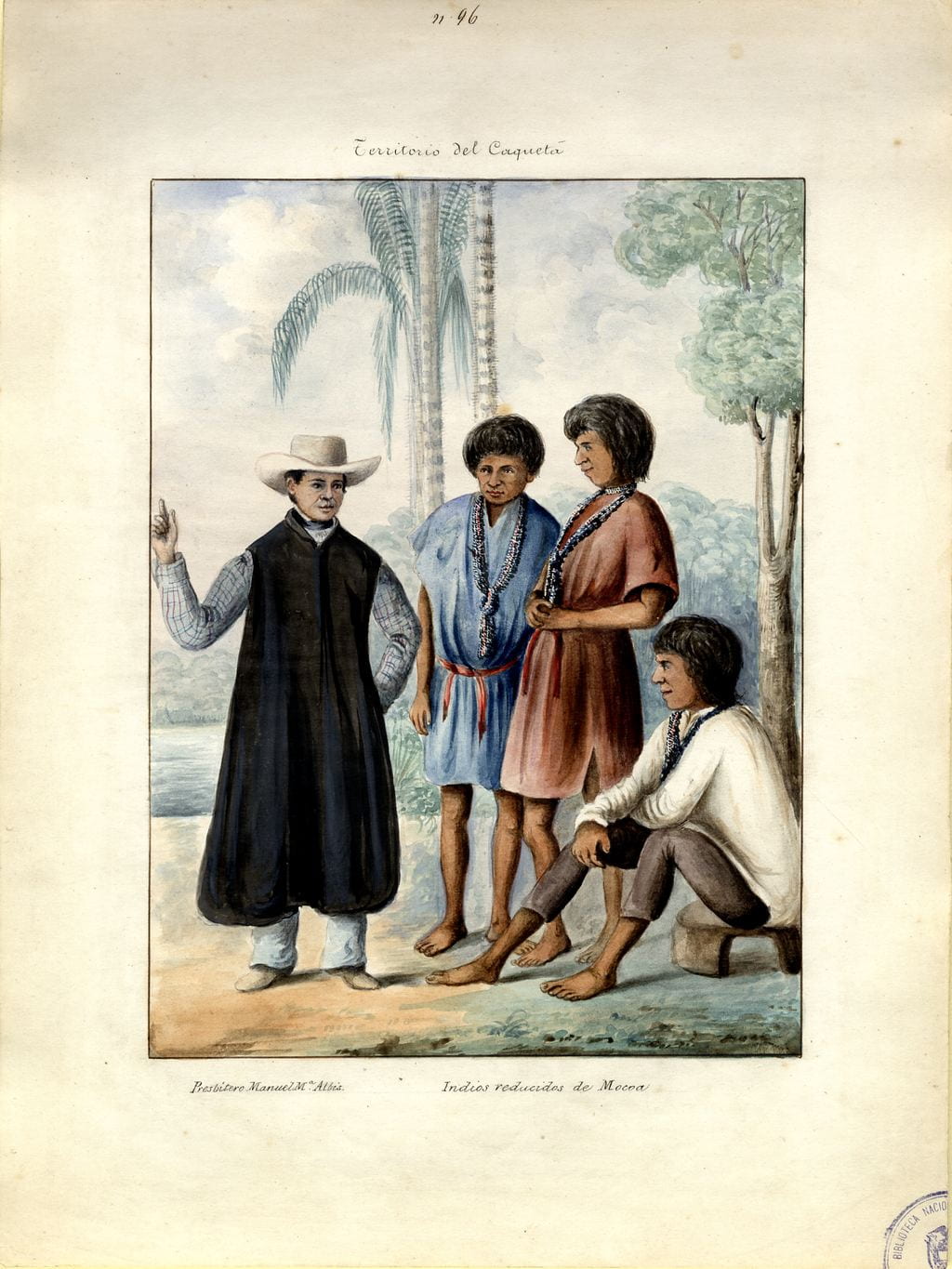
“Presbítero Manuel María Albis con indios reducidos en Mocoa”. Manuel María Paz. Presbítero Manuel María Albis con indios reducidos en Mocoa. Territorio del Caquetá. 1857 Acuarela sobre Papel. Biblioteca Nacional.
These watercolors bear witness that Albis covered great distances within the northwest Amazon—from the Andean highlands to Mocoa— for a priest who ought to main sedentary in his assigned town.
Perhaps his nomad character merely illustrates the tenuous nature of his tie with his bishop. Originally from Alto Magdalena, Albis surely knew the history of Caquetá as a refuge with little government control, a borderland, like others, which presented a temptation to escape from tax, military or work pressures (Scott 30). A vernacular knowledge should maintain alive those flows between the Magdalena basin and the Amazon in the centuries that elapsed between the forced displacements of indigenous peoples during the Spanish conquest, passing through the colonial routes of runaway slaves to the flight of deserters during the Wars of Independence. These routes were probably in use in the mid-19th century, given the civil wars that bore witness to the fact that “the more a state pressed its subjects, the fewer subjects it had. The frontier underwrote popular freedom,” as Scott observed.
As a result of his journeys, Albis produced Curiosidades on a notebook made of handmade paper and written with “salt, vinegar and verdigris.” In the style of missionary memoirs, he catalogs in the notebook the customs, languages, animals and plants of this region. However, before attempting to order this world, he realizes its instability through a practice that is the opposite of that of the sketcher. The manuscript, which was not edited and published until 1991 when Alberto Guaraldo brought it to public light in Italy, narrates in a fragmented style the several trips that Albis made in Caquetá. During these trips, he documented the life of several indigenous and Afro-descendant communities at the same time he was documenting his own experiences in ranges of tone as dissimilar as a humorous or elegiac poems, travel writing, drawing, population charts and glossaries.
From the very first paragraphs, he begins to paint himself as an “anti-hero” or “a poor traveler” at the same time as he characterizes his text as a “nonsensical notebook.” Albis is aware of the precariousness of language, of his body and even of his “civilizing mission” to reduce—put in context and create order out of— the multiple aspects of life in the borderlands. He does not speak indigenous languages and he does not have access to an infrastructure of cargo boats, maps and informants on which other travelers could rely. Unlike many of them, he confesses his fear of snakes; he is upset by some of the stories he hears, and he is conscious of the difficulty implied of making sense, as a traveler, of local practices and customs. The awareness of not understanding comes from the fact that he experiences Caquetá as a place distinct from Colombia. To enter into the “mountains” means “to separate oneself from the society of fellow countrymen.”
This foreign space is one in which natural threats abound, but where one does not try to see the world as a mere reflection of one’s own world. Albis fears the “wild beasts” and the “mud and precipices that await the poor traveler. ” He knows, because he has heard, of the way in which indigenous communities have reacted by using poison darts to confront missionaries who have preceded him. Because of that, he confesses that he is fearful that “he will be poisoned if he rubs the Indians the wrong way.”
The awareness of losing one’s sense of body because of sickness or lack of understanding, is an experience often expressed in fear of the other. Albis writes, “he who is not used to seeing or hearing the Indians is frightened by them because they certainly inspire respect without understanding what they are saying and here one thinks badly of the poor wretch who doesn’t understand a word they say” (Curiosità, 126). This lack of understanding led Albis to compile glossaries. However, in the face of the complexity of the task, he decided to confess his ignorance. In writing a glossary for the“guaque” tongue, Albis soon recognized there was too much of a chasm between this language and the words in Spanish. Before transforming himself into a translator of the shatter zone for the “civilized country”—assimilating them in the process—he was aware of the impossibility of appropriating the difference. Unable to put together a grammar book, he compiled three glossaries for the “guaque,” “coreguaje” and “andaquí” tongues. These short glossaries are a compendium lacking any organization except for Spanish alphabetical order. The glossaries have words beginning with the letter “a” like agua for water and ending with “z” like závalo, the Spanish term (now written with an “s”) for the Latin Prochilodus lineatus. Before providing a method of interaction with the indigenous population, they make us aware of the what the traveler is lacking. In the area of liquids: water, lemon, orange. In food: hen, sardines, bananas. In clothing: cotton, poncho. Even in bedding: a hammock.
Unlike the compartamentalized knowledge that contemporary sketchers of manners use to divide up the animal and vegetable realms, he sees a cultural landscape where there is a continuum of movement between the human, animal and plants, connected by customs. He draws snakes, bats and birds in movement. These drawings are accompanied by stories in which these animals employ human practices. He tells us convincingly, like Miguel and Pedro Mosquera, multilingual Afro-descendants who serve as his guides, that rats transform themselves into bats at night. “Mister [sor] Miguel Mosquera, his wife and family, told me that many times they had seen in the caves of the trees and dry trunks that they have observed that rats turn into bats.” After documenting this “curious novelty,” Albis paints it. Without writing a caption or an explanation, we see in his illustration three bats, with small changes in ink above the head, representations of power to transform into bats.

Murciélagos. Manuel María Albis. “Murciélagos”. Vinagre y cardenillo. En Cusiositá della foresta d”amazzonia e arte di curar senza medico”. Edición, traducción y notas Alberto Guaraldo. Torino: Il Segnalibro, 1991.
This world in movement can also been seen in the illustration that depicts the bird “Chamón”.
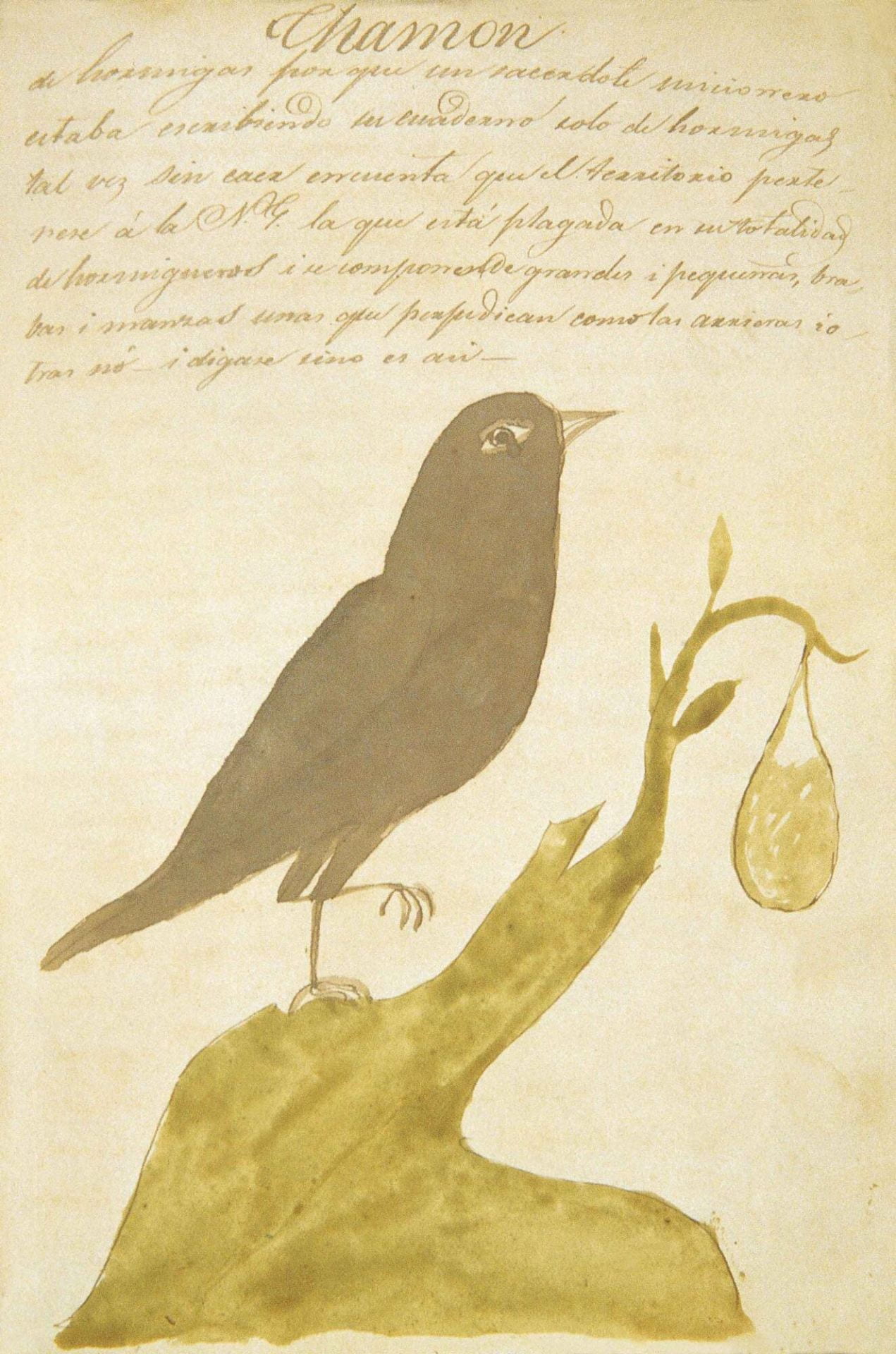
“Chamón”. Manuel María Albis. “Chamón”. Vinagre y cardenillo. En “Curiositá della foresta d”amazzonia e arte di curar senza medico”. Edición, traducción y notas Alberto Guaraldo, Torino: Il Segnalibro, 1991.
The indigenous people tied up this bird to give to Albis, who cut its wings. From this moment, Albis began to “investigate the life [of the bird]” talking with “the Indians” (215). As a result of this conversation, we learn that this bird, just like some men, leaves their eggs in the nests of other birds. Once these animals —like children— have grown and “are useful”—that is, ready to work—the parents, like the Chamón bird, return for them. With this anecdote, he shows us how natural history is the history of men and vice versa. Just as the rats/bats or the communities of the shattered zone, the Chamón is in movement —its foot raised and his gaze fixed on us— to show us that life has more sense than the painting (el cuadro) framing the image.
Reading about these beliefs shared among descendants of runaway slaves, outlaws and indigenous people, the shatter zone is presented to us as a space that makes Albis reconsider his repertory of beliefs—he, a priest, who ought to propagate them— in order to incorporate other forms of knowledge. Thus, just as language is not translatable, customs cannot be appropriated. The compilation of human practices that he demonstrates does not allow us to see a surplus economy, but rather represent subsistence practices bases on basic products that are not exportable: obtaining worms, taking care of birds and dogs, activities not intended for accumulation that are physically sterile for the state, as Scott has observed of other communities who lived in the so-called Southeast Asia Massif. Instead of showing, as do the picturesque sketches of manners of time, the transformation of nature into capital through work, in these drawings, it is practically impossible to distinguish what is leisure and what is work. This is the case of paintings made with vegetable colors such as “burning of ants”.
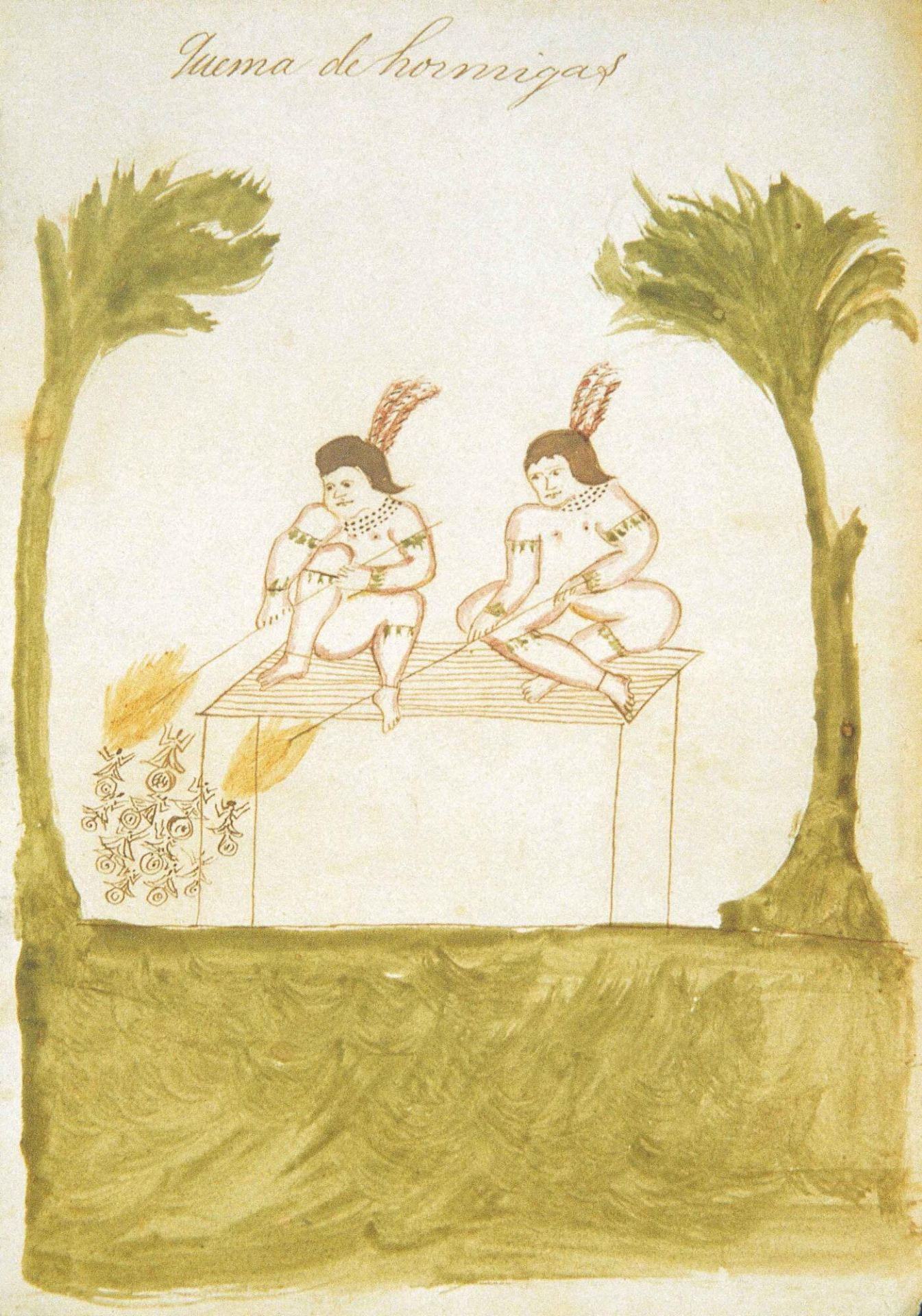
Manuel María Albis. “Quema de hormigas”. Vinagre y cardenillo. En “Curiositá della foresta d”amazzonia e arte di curar senza medico”. Edición, traducción y notas Alberto Guaraldo, Torino: Il Segnalibro, 1991.
“Indigenous woman sucking on dog’s nostrils” o “indigenous woman taking care of birds” that document practices that do not create accumulation.
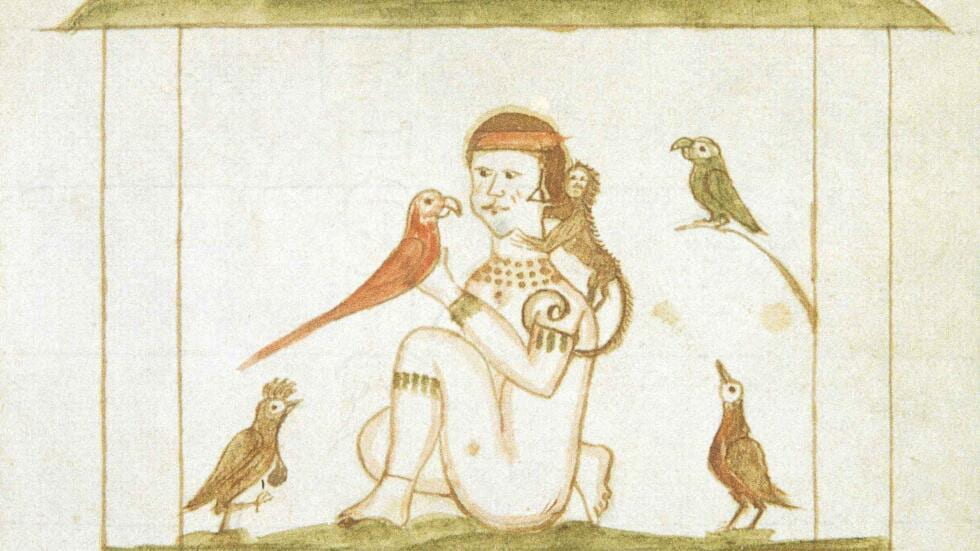
“La india cuida a los pájaros”. Vinagre y cardenillo. En Cusiositá della foresta d”amazzonia e arte di curar senza medico”. Edición, traducción y notas Alberto Guaraldo, Torino: Il Segnalibro, 1991.
Curiosidades shows us how in the shatter zones the conventions of superiority of the traveler are suspended when one goes to live in them: neither Spanish nor translation permit direct access to this world; thus, just as the associations among being sedentary, work and culture are unraveled. But even more important, the genre of picturesque sketches of manners—its relationship with laboral disciplines through typologies— are revealed to us as a precarious repertory that registers a reality that cannot be captured. Finally, Curiosidades is a document that shows us the life of the shatter zone before the rubber boom that would produce the genocide of so many of these communities.
This text is an abridged version of a chapter about this notebook that will be published in the forthcoming book Patricios en contienda: literatura panorámica y representación del pueblo en Colombia, Ecuador y Venezuela (1830-1880) in the NCSRLL series of UNC Press.
Un “disparatado cuaderno”
Curiosidades de la montaña de Manuel María Albis
Por Felipe Martínez-Pinzón
El siglo XIX nos siguen habitando de muchas maneras. Una de ellas son las tipologías nacionales. Vaqueros, gauchos, cosecheros o charros componen un portafolio de imágenes pintorescas que hacen el tránsito hoy, sin mayores cuestionamientos, a películas, carteles publicitarios o imágenes de la agroexportación, como la Juan Valdés. Revisitar estas tipologías es también preguntarse por qué algunas de ellas amasaron más poder simbólico que otras. El cuaderno del religioso Manuel María Albis es una incursión en un portafolio de tipologías descartadas, incómodas, que no le sirvieron a la nación —o a los forjadores del nacionalismo decimonónico— para hacer con ellas una imagen de una comunidad moderna. ¿Por qué? El cuaderno que propongo recuperar en estas pocas páginas nos trae de vuelta una comunidad que no tiene deudos: las comunidades de rochela, compuesta por desertores, comunidades indígenas y cimarrones, que existían en los pliegues o fronteras de un Estado que presionaba a sus sujetos a huir. La fascinación que este texto me produjo provino del mismo impulso por cuestionar cómo y con qué agenda se construyen los autoretratos colectivos de la nación bajo la forma de tipologías.
Curiosidades de la montaña y médico en casa (Curiosidades) por Manuel María Albis (1823-¿?) es un libro fascinante para quienes están interesados en la historia y literatura sobre la Amazonía. Sin embargo, su autor, un religioso y viajero colombiano, sigue siendo un desconocido para la historiografía latinoamericana. Gracias a la poca, pero importante bibliografía en torno a él, en este corto texto quiero reintroducir la figura de Albis, así como su único texto conocido,Curiosidades es uno de los pocos textos acerca del Caquetá en la Amazonía noroccidental colombiana en el medio siglo 19 y es de suma importancia para pensar el mundo de las rochelas [shatter zone] plurilingües sin el lente de escritores de costumbres nacionalistas o de viajeros europeos. Los “shatter zones” son espacios plurilinguísticos y pluriculturales que están caracterizados por “su inaccesibilidad geográfica y su enorme diversidad de lenguas y culturas,” según John C. Scott en The Art of Not Being Governed: An Anarchist History of Upland Southeast Asia (New Haven: Yale University Press, 2009).
Sólo existe una edición del libro de Albis. Se trata de una valiosa edición bilingüe italiano-español, preparada por Alberto Guaraldo en Turín (Italia) en 1991, en donde se encuentran los archivos de Codazzi, dentro de los cuales se encontró el cuaderno. La otra edición es parcial y está subordinada a los materiales producidos por la Comisión Corográfica. Es parte de la importante edición que hicieron Camilo Domínguez Ossa, Augusto Gómez y Guido Barona de compilar los materiales de Codazzi como líder de la Comisión Corográfica. En 1855 José María Vergara y Vergara y Evaristo Delgado produjeron, a partir de reescrituras y censuras de Curiosidades, otro texto -muy distinto al original- a partir de Curiosidades. Lo titularon Los indios del Andaquí: memorias de un viajero.
De poca educación formal, y tal vez entrenado por los jesuitas, en sus Curiosidades Albis maneja más el repertorio de escritura misionera del siglo 18 que la de los escritores de costumbres contemporáneos suyos que escribían acerca de tipologías en la prensa. Nacido en el actual departamento del Huila, Colombia, párroco de la aldea de Garzón, Albis parte hacia el Alto Río Caquetá en 1854, así como nos describe el italiano Alberto Guaraldo en“I Lunghi Viaggi di un Manoscritto Amazzonico”. (Turín: Il Segnalibro, 1991), 8-19.) La pregunta por las razones que lo llevaron a irse a estas regiones de frontera abierta —llamadas por Silvia Benzo, “la Colombia menor” (Curiositá, “Un curioso quaderno”, 21)— no son claras. A partir de las pocas fuentes disponibles sobre su vida, es posible pensar que huyó de la disciplina eclesiástica y del reclutamiento militar. En contra de su voluntad, su superior, el obispo de la ciudad de Popayán, Manuel María Bueno, le ordenó hacerse cura de su diócesis, a lo cual “mal avenido ya con las prácticas de la civilización prefirió huir de lo que llamaba su esclavitud, y se refugió en una aldea llamada La Ceja, esperando la ocasión oportuna para internarse de nuevo en los bosques” (José María Gutiérrez de Alba, Diario ilustrado de viaje por Colombia 1871–1873. Bogotá: Villegas Editores, 2012. 280-281). Su desatención a las órdenes de su superior podrían haberlo puesto a merced del reclutamiento militar de la guerra civil de 1854. Albis se encontraba no sólo en una región conflictiva sino con la edad conveniente para ser reclutado (más o menos 30 años). Sabemos además que había tenido fatídicas experiencias como recluta en la guerra civil de 1851 (Gutiérrez de Alba, Diario 280).
Como posible trásfuga, Albis será un desertor lo mismo que un misionero en tiempos de ataque gubernamental al sistema de las misiones, dado que la expulsión final de los jesuitas en Colombia se haría efectivo en abril de 1853. Lo encontramos en 1854, viajando a espaldas de un carguero, entre las poblaciones Inga cercanas a la cordillera occidental.

Albis con cargueros. “Crédito de las demás…”. Vinagre y cardenillo. En Cusiositá della foresta d”amazzonia e arte di curar senza medico. Edición, traducción y notas Alberto Guaraldo, Torino: Il Segnalibro, 1991.
De acuerdo con las acuarelas, libre e informes de la Comisión Corográfica (1850-1859)—el esfuerzo más importante del siglo 19 colombiano por crear un mapa y un pueblo nacionales— en su séptima expedición al Caquetá en 1857, vemos a Albis como “cura en Mocoa” tal vez sin designación oficial alguna (Agustín Codazzi, Viaje de la Comisión Corográfica por el territorio del Caquetá 1857 [Bogotá: Coama/Fondo FEN/Instituto Geográfico Agustín Codazzi, 237]).

“Presbítero Manuel María Albis con indios reducidos en Mocoa”. Manuel María Paz. Presbítero Manuel María Albis con indios reducidos en Mocoa. Territorio del Caquetá. 1857 Acuarela sobre Papel. Biblioteca Nacional.
Estas acuarelas dan cuenta de cómo Albis cubrió una gran distancia dentro la Amazonía noroccidental —del piedemonte andino a Mocoa— para un cura que debía permanecer sedentario en la aldea de su control.
Acaso su carácter nómada nos muestre la calidad tenue de sus vínculos con el obispado. Tal vez oriundo del actual departamento del Huila, Albis con seguridad conocía la historia del Caquetá como refugio con poco control gubernamental, una frontera, como otras, que constituía una tentación para escapar de las presiones fiscales, militares o laborales (Scott 30). Un conocimiento vernáculo debía mantener vivos los flujos entre la cuenca del Magdalena y del Amazonas en los siglos que mediaron entre los desplazamientos forzados de indígenas durante la conquista española, pasando por las rutas coloniales del cimarronaje hasta la fuga de desertores durante las Guerras de Independencia. Estos caminos debían estar en uso durante mediados del siglo 19 debido a las guerras civiles que ponían en evidencia que “entre más el Estado presionara a sus sujetos, menos tenía. La frontera significaba libertad popular,” como decía Scott.
A partir de sus viajes Albis produjo Curiosidades como un cuaderno hecho de papel prensado y escrito con “sal, vinagre y cardenillo.” A la manera de la memoria misional, allí cataloga las costumbres, lenguas, animales y plantas de esta región. Sin embargo, antes que ordenar este mundo, da cuenta de su inestabilidad a través de una práctica contraria a la del sketcher. El manuscrito, sólo editado y publicado en 1991 por Alberto Guaraldo en Italia, narra fragmentariamente los varios viajes que hizo por el Caquetá. Durante ellos documentó la vida de diferentes comunidades indígenas y de afrodescendientes al tiempo que la suya propia en registros tan disímiles como el poema humorístico o elegiaco, el relato de viaje, dibujos, cuadros poblacionales y glosarios.
Desde los primeros párrafos comienza por retratarse como “anti-héroe” o “pobre viajero” al tiempo que representa su texto como un “disparatado cuaderno.” Albis es consciente de la precariedad de su lengua, de su cuerpo y aún de su “misión civilizadora” para reducir —encuadrar y someter al orden— la vida múltiple de la frontera. No maneja las lenguas indígenas y no cuenta con la infraestructura de cargueros, mapas e informantes con la que contaban otros viajeros. A diferencia de muchos de ellos, nos hará participes de los miedos a las serpientes, se inquieta con las historias que escucha y es consciente de la dificultad que implica dar razón de las costumbres. La consciencia de no entender proviene de que vive el Caquetá como un lugar distinto a Colombia. Entrar en las “montañas” implica “separarse de la sosiedad de sus compatriotas”. Este espacio ajeno es uno donde la amenaza natural abunda, pero donde no se trata de ver el mundo como mero reflejo del propio. Albis le teme a “las fieras” y a los “fangos i despeñadores que se precentan al pobre viajero” (aquí sigo la edición de Guaraldo que respeta el original y transcribo del cuaderno sin alterar la ortografía usada por Albis). Sabe, porque ha oído, de la manera en que las comunidades indígenas han reaccionado frente a misioneros que lo antecedieron haciendo uso del veneno. Por ello, confiesa que siente miedo a “verse en venenado [envenenado] si lo aborrecen los indios”.
La conciencia de estar perdiendo el cuerpo, por la enfermedad, y la lengua, por la incomprensión, es una experiencia que vive como un miedo a la otredad. Escribe Albis “[e]l que no está acostumbrado a ver ni oír a los indios le da mucho miedo porque ciertamente infunden respeto sin saber qué es lo que hablan y he aquí que lo hacen pensar feo al pobre que nada les entiende” (Curiosità, 126). La incomprensión lo lleva a compilar glosarios. Sin embargo, ante la complejidad de la tarea, decide confesar su ignorancia. Al escribir un glosario de la lengua “guaque” Albis pronto se da cuenta de que las diferencias entre las palabras en esta lengua y las palabras en español son insalvables. Antes que convertirse en un traductor de la rochela para el “país civilizado” —asimilándolas—tiene una conciencia de la imposibilidad de apropiarse de la diferencia. Al no poder componer una gramática, compila tres glosarios para las lenguas de los “guaque”, “coreguaje” y “andaquí”. Estos cortos glosarios son un compendio sin ningún principio organizativo más que el abecedario español. Contienen palabras que empiezan por la letra “a”, como agua, y terminan por palabras que empiezan por “z” como závalo. Antes que proveer un método de interacción con las poblaciones, estos glosarios nos hacen conscientes de las carencias del viajero. De líquidos: agua, limón, naranja. De comida: gallina, sardina, plátano. De vestido: algodón, poncho. Inclusive de cama: hamaca.
A diferencia de la lógica lineana que siguen los escritores de costumbres al dividir los reinos animal y vegetal, ve un paisaje cultural donde hay una continuo en movimiento entre lo humano, lo vegetal y lo animal conectado por las costumbres. Albis retrata víboras, murciélagos y pájaros en movimiento. Estos dibujos van acompañados de relatos a través de los cuales estos animales movilizan prácticas humanas. Albis nos cuenta que está por creer, al igual que Miguel y Pedro Mosquera, afrodescendientes multilingües que lo guían, que los ratones se convierten en murciélagos por las noches: “El sor. Miguel Mosquera, su sa [señora] i fama [familia], me contaron que muchas veces habían visto en las cavernas de los arboles i troncos secos que los Ratones se volvían Murcielagos que los habían observado”. Tras documentar esta “curiosa novedad”, Albis la pinta. Sin escribir debajo suyo un nombre o una explicación, vemos en esta ilustración tres murciélagos, con leves cambios de tintura sobre la cabeza, representaciones del poder transformativo del ratón en murciélago.

Murciélagos. Manuel María Albis. “Murciélagos”. Vinagre y cardenillo. En Cusiositá della foresta d”amazzonia e arte di curar senza medico”. Edición, traducción y notas Alberto Guaraldo. Torino: Il Segnalibro, 1991.
Este mundo en movimiento también se ve en la ilustración que retrata al pájaro “Chamón”.

“Chamón”. Manuel María Albis. “Chamón”. Vinagre y cardenillo. En “Curiositá della foresta d”amazzonia e arte di curar senza medico”. Edición, traducción y notas Alberto Guaraldo, Torino: Il Segnalibro, 1991.
Los indígenas enlazan a este pájaro y se lo regalan a Albis, quien le corta las alas. A partir de este momento, Albis empezó a “averiguarle la vida [al pájaro]” hablando con “los indios” (215). Producto de esta conversación, nos enteramos de que este pájaro, al igual que algunos hombres, deja sus huevos en los nidos de otros pájaros. Una vez estos animales —como los niños— han crecido y “están de servicio” —es decir, listos para trabajar—los padres, como el pájaro Chamón, vuelven por ellos. Con esta anécdota se nos revela cómo la historia natural es la historia de los hombres y viceversa. Al igual que los ratones/murciélagos o que las comunidades de la rochela, el Chamón está en movimiento —su pata alzada y la mirada nos interpelan— para mostrarnos que su vida tiene sentido más allá del cuadro que lo detiene.
Al leer estas creencias compartidas entre descendientes de cimarrones, prófugos e indígenas, la rochela se nos presenta como un espacio que le hace a Albis reconsiderar su repertorio de creencias —él, religioso, que debía administrarlas— para incorporar otras formas de conocimiento. Así como la lengua no es traducible, las costumbres no son apropiables. La compilación de prácticas humanas que pinta no deja ver una economía excedentaria, sino que representa prácticas de subsistencia a partir de productos no exportables: procura de gusanos, cuidado de pájaros y perros, actividades fiscalmente estériles para el estado, como observa Scott. En lugar de mostrar, como los cuadros de costumbres de la época, la transformación de la naturaleza en capital a través del trabajo, en estas tintas aparecen prácticas donde no es discernible qué es ocio y qué es trabajo. Es el caso de pinturas vegetales como “quema de hormigas”, “india chupa la nariz del perro” o “india cuida los pájaros”que documentan prácticas que no crean acumulación.
- Manuel María Albis. “Quema de hormigas”. Vinagre y cardenillo. En “Curiositá della foresta d”amazzonia e arte di curar senza medico”. Edición, traducción y notas Alberto Guaraldo, Torino: Il Segnalibro, 1991.
- “La india cuida a los pájaros”. Vinagre y cardenillo. En Cusiositá della foresta d”amazzonia e arte di curar senza medico”. Edición, traducción y notas Alberto Guaraldo, Torino: Il Segnalibro, 1991.
Curiosidades muestra cómo en las rochelas se suspenden las convenciones de superioridad del viajero cuando este pasa a vivir en ellas: ni el español ni la traducción permiten un acceso directo a este mundo; así como las asociaciones entre sedentarismo, trabajo y cultura se destejen. Pero de manera más importante, el género del cuadro de costumbres —su relación con las disciplinas laborales a través de las tipologías— se nos muestra como un repertorio precario que da cuenta de una realidad que lo excede. Por último, Curiosidades es un documento que muestra la diversidad de la vida de la rochela [shatter zone] antes del boom cauchero que produciría el genocidio de muchas de estas comunidades.
Este texto es una versión reducida de un capítulo sobre este cuaderno que aparecerá en el libro Patricios en contienda: literatura panorámica y representación del pueblo en Colombia, Ecuador y Venezuela (1830-1880).
Spring/Summer 2020, Volume XIX, Number 3
Felipe Martínez-Pinzón is Assistant Profesor of Hispanic Studies at Brown University.
Felipe Martínez-Pinzón es Profesor Asistente de Estudios Hispanos en la Universidad de Brown.
Related Articles
Amazon: Editor’s Letter
The Amazon is burning. The trees that have not been cut down are on fire. The crisis is now. When I began to work on this issue on the Amazon, that was pretty much my vision, and it was a real one. I was determined to make the magazine on the Amazon about…
How Democracies Die
How Democracies Die analyzes the main dangers that modern democracies face. As the authors warn, 21st-century democracies do not die in one fell swoop, in a violent way, by hands that do not always belong to the political system. On the contrary, modern democracies…
The Return of Collective Intelligence
My college Native American Culture professor, the Mescalero Apache scholar Inez Sánchez, told our class that we should regard the word “primitive” as synonymous with “complex.” I gained a better understanding of what Sánchez meant reading The Return of Collective…

